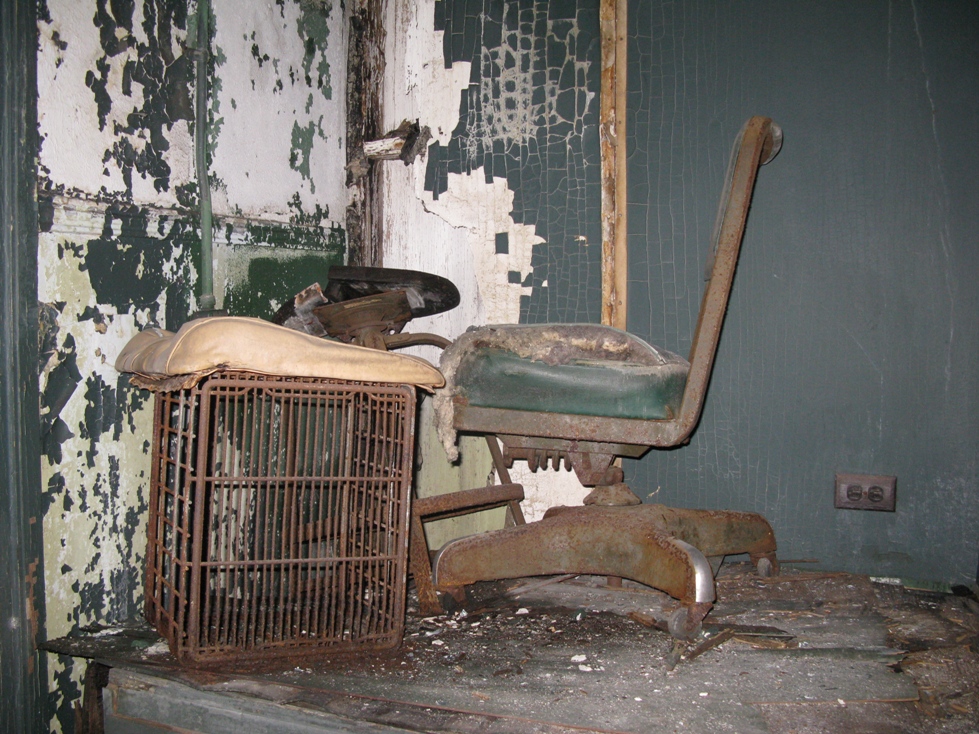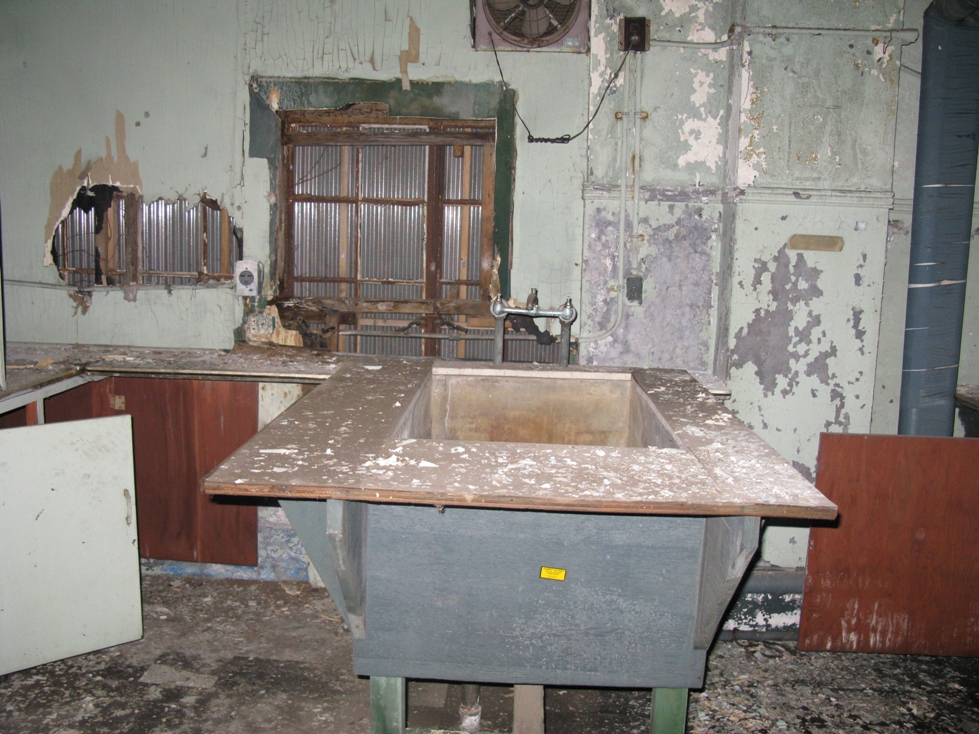The Negishi Racecourse Grandstand in Yokohama looms like an ancient 3-headed Titan over the Negishi Plateau. It once drew crowds of thousands to cheer the racing horses from its elaborate bleachers, to wander its long hallways and admire its extravagant architecture, but that was over 80 years ago, before it was surrendered to the US military after World War Two. Now its racecourse is a floodlit naval base, its bleachers are fenced off and overgrown with ivy, its innards rest silent and dark but for the steady drip of rain-water leaking through its rotting concrete skin.
The Negishi Grandstand was built by the prolific American architect J.H. Morgan, who also designed churches, movie theaters, homes, and office towers around Yokohama and other Japanese cities. It stands an order of magnitude older and more interesting architecturally than any other haikyo I’ve explored in Japan so far, though it was also far more central and more difficult to gain access to. I arrived with my friend Mike at around 11pm, armed with googlemaps and gear for sleeping over. I thought we were well-prepared, but upon arrival we were shocked at how bright and proximal the Navy Base was, how tall the plate metal fence was, and how frequent the parade of passersby was. We umm-ed and ahh-ed for a long time, waiting for the surrounding park to clear of dog-walkers and kissing couples (until past 1am), then for the sailors on base to clear away from the entrance to their bar (past 2am). We made a few forays over the exterior fence, and finally I went over the interior plate metal fence. It stood about 8 feet high, too high to jump and grab the lip of, but happily there was a pipe nearby I could brace against and work my way up. Getting Mike over the fence was a little troublesome, but as a team we got him up and over. We left our bags with all our camping gear down by the fence, realizing there was no way we would sleep there then try to leave in full daylight. On the other side of the fence the bleachers were a jungle, completely overgrown with creepers and bushes and tangled vines. We pushed through, checking every potential entrance to the grandstand complex, but they were all boarded up securely but for the final one, which had had a hole smashed into it. It was almost completely black inside, but for a few shreds of orange base floodlight filtering through the chinks in the boarding covering all windows and doors. This meant only flash photography, which means some sterile photos. Also, the whole place had been gutted a long time ago, so almost all furniture was missing, leaving us with a lot of empty rooms and long empty hallways. Both Mike and I took video, it’s very dark, but it gives a good feel for the place. Here it is:
And here are the best of the photos:
This was the most interesting room, with some color on the walls, some furniture, and some weird scribbles:
This room had a lot of sinks:
We ascended to the top of the middle tower, the 8th floor, and took some night shots- this is looking back to Yokohama:
That’s the west tower.
And the east. After taking multiple shots from the roof, the dawn started to break through the cloudy skies, it was around 4:30am, and we decided to hurry down and out. We came down different stairs than we went up, got ourselves turned around, but finally came to a newly built exit that we’d seen from the outside, but that had been locked. We turned the lock and exited out into the dawn air, completely by-passing the plate-metal fence climb-down neither of us had been looking forward to. And then we were out! I took pictures of the grandstand’s exterior.
This is the pipe and metal fence we had to negotiate to gain entry. You can see how overgrown it is:
2 exhausted explorers, feeling like we’d been out all night in a night-club, ready to go home.
As a haikyo, this place was good for its age and the sense of history upon it, but being completely gutted on the inside and so difficult to gain daylight entry to made it less than I’d hoped for. Here’s a gallery of all the photos:
FACTFILE
Location– Yokohama. Entry – Difficult, over several fences. Highlights– Waiting all night for the coast to be supremely clear, the darkness inside, owning the place from the roof.
RUINS / HAIKYO
You can see all MJG’s Ruins / Haikyo explorations here:
[album id=4 template=compact]




























Comments 60
A lot of memories reading this blog. My dad was stationed at Kamiseya from ’69 to ’72. We lived in Negishi Heights, so spent plenty of time roaming the area, including the Grandstand. i remember eating at the small restaurant at the golf club, which was located across the track from the Grandstand. Soon after we arrived, probably in 1970, the golf course, which was in the center of the racetrack (actually a circular road, as others have mentioned), along with the clubhouse was returned to the Japanese. It remained a golf course for while before becoming a park. At the time, the SP office was there along with the motor pool. There were some administrative services there as well, as i remember getting ID cards there. The pictures of the head look familiar. That area was closed off, as i remember, but only by an unlocked door. I also remember taking guitar classes there. Somewhere in the building is an elevator. I remember this as my 5th grade teacher, Mr. Brown, was in the building on a Saturday for some reason or other. He was waiting for the elevator, and when the door opened, stepped in. However, the elevator wasn’t there. He fell down the shaft, injured his head and wasn’t discovered until Monday morning. He was medevac’d out and we had another teacher for the rest of the year.
We used to roam through the bamboo, particularly along the cliffs. We did discover one of the caves down there.. We went in a short way, but were nervous and never went very deep. We did discover an empty rifle rack, though. We assumed the cave was used as a bomb shelter from the U.S bombers, maybe by the Japanese military or civilians. A sign of the times, we used to see empty plastic bags of glue all over the bamboo areas from the glue sniffers. They must have come out at night, as we never saw them.
I lived in military (Army) housing on the hill above the race rack. As I recall more of the race track was in existence then, in 52 to 54. A substantial number of Japanese families lived in the stadium at that time. I was 7 and eight years old then and really loved living there. The Japanese love children and my friends and I were always greeted with smiles, which we were happy to return. We could see Fuji from our house on clear days, and we played in the bamboo groves and in the dugout caves as well. One time my dad, who was an Ordnance officer, took me down to the harbor, where we observed men with geiger counters checking out frozen, radioactive tuna that had ven contaminated by US nuclear testing in the Pacific. What great times!
I remember Mr. Brown. We must have been in the same class. Remember his replacement? Ms. Block I tnink it was…. I always wondered whatever happened to Mr. Brown. My friends and I did our share of exploring of the Grandstand. Scary place. Remember the youth center that was there…and the model car race track they had there?
Mr. Brown taught at Sullivans through the late 90’s. I had him in 3rd grade. I think he left when I was in 5th grade in 1997.
Lived in quarters at Negishi ‘49-‘52 when it was Army housing. Definitely remeber the racetrack grandstands. Japan was rebuilding after the war. A lot of trucks and buses still ran on wood-gas, generated from huge cylindrical boilers on the backs of the vehicles.
Believe it was also originally called ‘Area X’. Ours was a duplex.
Huge typhoon blew the roof off a warehouse our some kind of outbuilding behind our quarters. Remember the Sunday the North Koreans invaded the South. Went to St. Joseph International School in Yokohama.